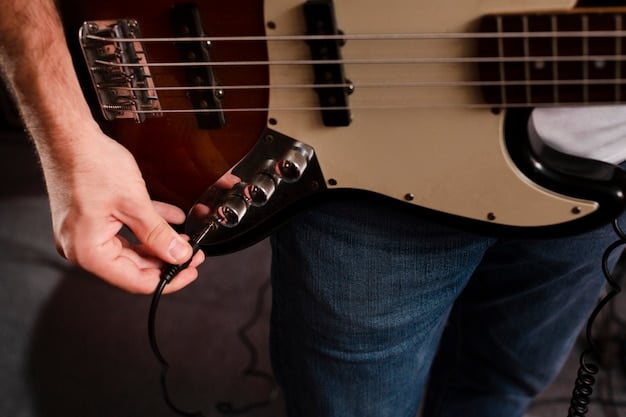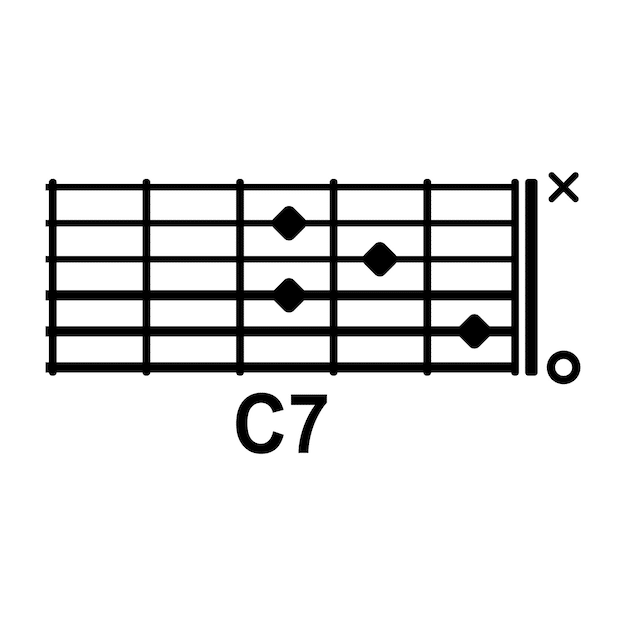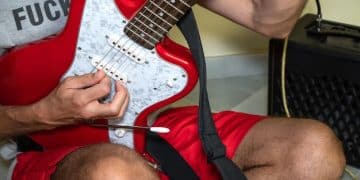Progressive Metal Guitar: Techniques to Master Complex Riffs and Solos

Progressive metal guitar focuses on pushing musical boundaries through complex rhythms, unconventional harmonies, and advanced soloing techniques, demanding a high level of skill and creativity from guitarists.
Progressive metal guitar is not just about playing fast; it’s about pushing the boundaries of musical expression through complex compositions and intricate techniques. This guide will delve into the core aspects of mastering those challenging riffs and soaring solos that define the genre.
Understanding Progressive Metal Guitar
Progressive metal, often referred to as prog metal, is a subgenre that combines the heavy metal sound with the complex compositional structures, instrumental virtuosity, and conceptual themes often found in progressive rock. This fusion creates a unique sonic landscape that demands both technical skill and creative vision from its practitioners.
Key Characteristics of Progressive Metal
Progressive metal distinguishes itself through several defining characteristics. Understanding these elements is crucial for any guitarist looking to explore this genre.
- Complex Time Signatures: Prog metal often uses odd or changing time signatures, creating rhythmic complexity.
- Extended Song Lengths: Songs tend to be longer, allowing for greater development of musical ideas.
- Technical Proficiency: High levels of instrumental skill are expected, with intricate riffs and solos.
- Conceptual Themes: Many bands explore complex lyrical themes, often with philosophical or fantastical elements.

Progressive metal guitar playing demands a unique approach to melody, harmony, and rhythm. It’s not enough to simply play fast; you need to understand how to weave intricate musical tapestries.
Essential Riffing Techniques
Riffing in progressive metal pushes beyond simple power chords. It involves complex chord voicings, syncopated rhythms, and innovative use of scales and modes. Here are some techniques to master.
Alternate Picking
The ability to pick every note cleanly and precisely is crucial for executing intricate riffs at high speeds. Practice exercises that focus on maintaining a consistent attack and tone across the strings.
Palm Muting
Palm muting can add a percussive element to your riffs, creating a tight, aggressive sound. Experiment with different levels of muting to find the right balance between clarity and heaviness.
- Down-Picking Emphasis: Emphasize down-strokes for a heavier, more aggressive tone.
- String Skipping: Practice riffs that require you to skip strings, improving your accuracy and dexterity.
- Hybrid Picking: Combine the pick with your fingers to create complex rhythmic patterns.
Mastering these riffing techniques requires consistent practice and attention to detail. Focus on building a solid foundation before attempting more advanced patterns.
Mastering Progressive Metal Soloing
Soloing in progressive metal is about more than just shredding. It’s about crafting melodic phrases that complement the underlying harmony and contribute to the overall composition. Let’s explore some of the key techniques.
Sweep Picking
Sweep picking allows you to play arpeggios across multiple strings with incredible speed and fluidity. Focus on maintaining a smooth, consistent motion and minimizing string noise.
Tapping
Tapping involves using your fingers to strike the strings on the fretboard, creating unique melodic and harmonic textures. Experiment with different tapping patterns and incorporate them into your solos.

Legato
Legato playing creates a smooth, flowing sound by minimizing the use of the pick. This technique relies on hammer-ons and pull-offs to connect notes, creating a seamless melodic line.
To enhance your progressive metal soloing, consider the following:
- Modal Improvisation: Explore different modes to add color and depth to your solos.
- Outside Playing: Incorporate notes that are outside the key to create tension and dissonance.
- Harmonic Exploration: Use advanced chord voicings and progressions to inspire your soloing.
Soloing is a journey, so take the time to experiment and find your own voice within the progressive metal landscape.
Understanding Time Signatures and Rhythmic Complexity
One of the hallmarks of progressive metal is its use of complex and unusual time signatures. This can be challenging for guitarists, but mastering these rhythmic concepts opens up a world of creative possibilities.
Common Time Signatures in Prog Metal
While standard time signatures like 4/4 are sometimes used, progressive metal often employs odd time signatures or frequently shifting meters. Some of the most common include:
- 7/8: A time signature with seven eighth notes per measure, creating a slightly off-kilter feel.
- 5/4: A time signature with five quarter notes per measure, often used to create a sense of unease or tension.
- 11/8: A time signature with eleven eighth notes per measure, offering a more complex and syncopated rhythm.
Polyrhythms and Polymeters
Polyrhythms involve playing two or more different rhythms simultaneously. Polymeters involve changing the time signature within a song, creating a sense of rhythmic instability.
Navigating complex rhythms requires practice and careful attention to detail. Start by practicing simple exercises that isolate the different rhythmic patterns, and gradually build up to more complex passages.
Essential Gear for Progressive Metal Guitar
The right gear can make a significant difference in your ability to achieve the progressive metal sound. While personal preference plays a role, certain types of equipment are commonly used in the genre.
Guitars
Many progressive metal guitarists favor guitars with high-output pickups, allowing for a clear, articulate tone even at high gain levels. Common choices include:
Amplifiers
Amplifiers with high headroom and versatile tone-shaping capabilities are essential for progressive metal. Popular options include:
- Seven-String Guitars: Seven-string guitars provide extended range, allowing for lower, heavier riffs.
- Eight-String Guitars: Eight-string guitars offer even greater range, opening up new possibilities for low-end experimentation.
- Extended Scale Length Guitars: Longer scale lengths can improve intonation and clarity, particularly with lower tunings.
Effects
Progressive metal guitarists often make extensive use of effects to create unique sonic textures. Some essential effects include:
Experiment with different combinations of gear to find the sound that inspires you. Don’t be afraid to try new things and push the boundaries of what’s possible.
Notable Progressive Metal Guitarists and Their Styles
Studying the styles of influential progressive metal guitarists can provide valuable insights into the techniques and approaches used in the genre. Here are a few key figures to explore:
John Petrucci
The guitarist for Dream Theater, John Petrucci is known for his incredible technical skill, melodic phrasing, and signature sweep picking.
Tosin Abasi
As the guitarist for Animals as Leaders, Tosin Abasi is renowned for his innovative use of eight-string guitars, tapping techniques, and complex polyrhythms.
- High-Gain Amplifiers: Amplifiers that provide plenty of distortion and sustain are essential for heavy riffs and soaring solos.
- Versatile Amplifiers: Amplifiers that allow you to dial in a wide range of tones, from clean to crushing, are ideal for progressive metal.
- Modeling Amplifiers: Modeling amplifiers offer a variety of amp simulations, allowing you to experiment with different sounds.
Mikael Åkerfeldt
The guitarist and vocalist for Opeth, Mikael Åkerfeldt blends brutal death metal riffs with intricate acoustic passages, creating a dynamic and atmospheric sound.
Analyzing the playing styles of these guitarists can help you develop your own unique approach to progressive metal guitar.
Practice Routines and Exercises
Consistent practice is essential for mastering the complex techniques required in progressive metal guitar. Here’s a sample practice routine to help you develop your skills:
Warm-Up Exercises
Start with simple warm-up exercises to prepare your hands and fingers for more demanding practice. This might include:
Here are a few practice tips to maximize your effectiveness:
- Chromatic Scales: Playing chromatic scales up and down the neck.
- Finger Stretches: Stretching your fingers to improve flexibility and dexterity.
- Arpeggio Exercises: Practicing arpeggios to improve your finger coordination.
Technique Drills
Dedicate time to practicing specific techniques, such as alternate picking, sweep picking, and tapping. Focus on accuracy and consistency, gradually increasing your speed as you improve.
Pause
Key Point
Brief Description
🎸
Mastering Riffs
Focus on alternate picking, palm muting and string skipping.
🎶
Advance Soloing
Sweep picking is key for playing arpeggios, and legato for smooth sounds.
⏱️
Time Signatures
Prog metal often uses complex time signatures like 7/8 or 11/8.
⚙️
Essential Gear
Seven or eight-string guitar, plus high-gain amps, are essential.
FAQ
▼
Progressive metal guitar involves complex rhythms, unconventional harmonies, and advanced soloing techniques,demanding high skill and creativity.
▼
Many progressive metal guitarists favor guitars with high-output pickups allow a tone even at high gain.
▼
Amplifiers with high headroom and tone-shaping capabilities, providing distortion for sustain are essentials the genre.
▼
Some of the most useful techniques are alternate picking, palm muting, string skipping and hybrid picking.
▼
John Petrucci, Tosin Abasi, Mikael Akerfeldt are great guitarists that you should check out.
Conclusion
Mastering progressive metal guitar is a challenging but rewarding journey that requires dedication, practice, and a willingness to push the boundaries of your playing. By focusing on essential techniques, understanding rhythmic complexity, and exploring the styles of influential guitarists, you can unlock your potential and create your own unique voice within this exciting genre.





